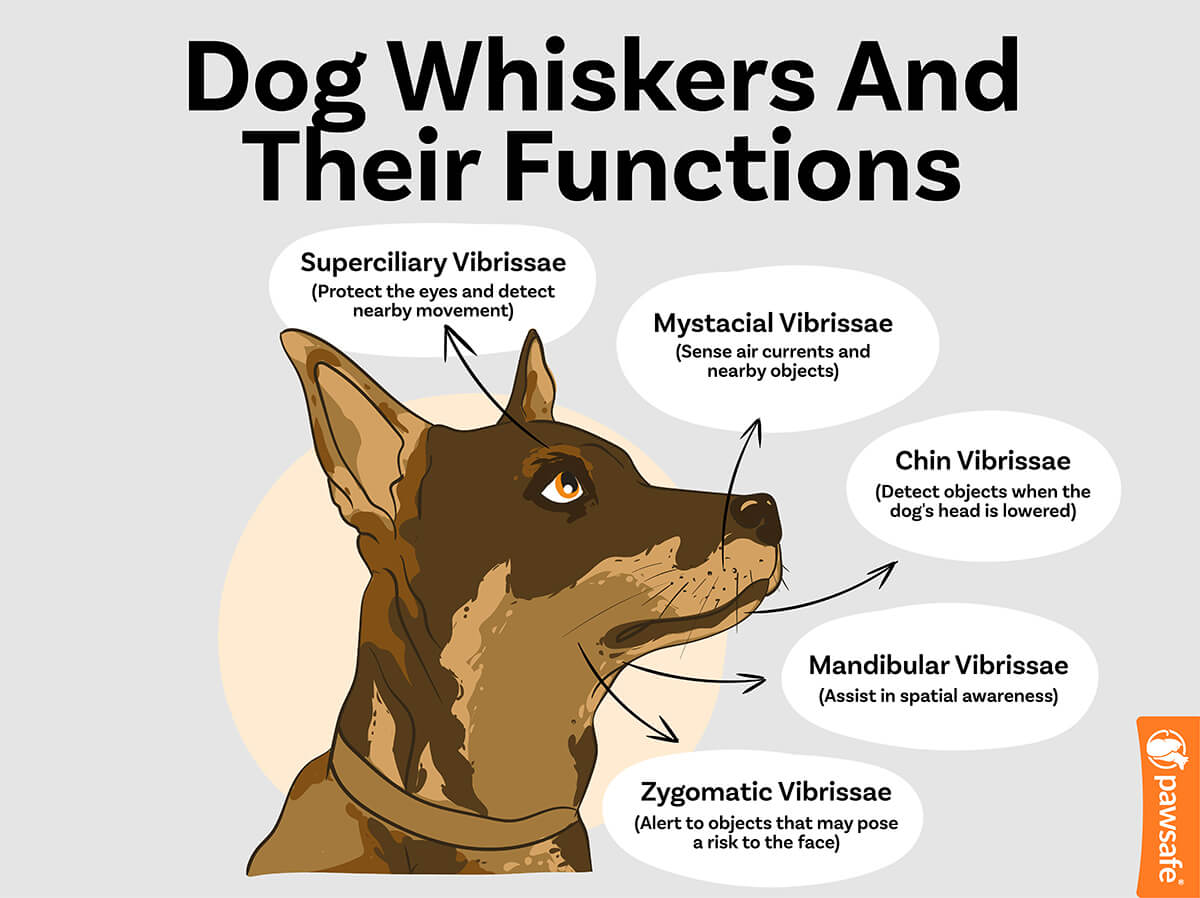
Some groomers and pet parents insist on trimming their dog’s whiskers for aesthetic reasons, but can you cut dog whiskers, or should you?
Also known as vibrissae, whiskers protrude from the jaw, the side of the muzzle, and above the eyes. Cut whiskers bears no benefits except a clean look that .
Whiskers are unlike normal dog hair that can be washed with a good canine body wash and trimmed as needed. For one, whiskers are thicker and have multiple sensory neurons that convey messages to your dog’s brain. A dog with most whiskers trimmed may seem disoriented until they adapt.
Table of Contents
Why do Dogs Have Whiskers?
Dogs have whiskers to sense and navigate their environment. All dog breeds have whiskers, regardless of whether they are hairless or curly. Dogs can also use their whiskers to convey information since these hairs add expression to a dog’s face.
Most mammals, except humans, have sensory tactile hairs called the vibrissae. Even humans had whiskers until about 800,000 years ago when whiskers lost function due to uprightness, sensitive fingers, and good vision.
Whiskers in dogs vary in appearance, with some being shorter or longer in long-haired breeds like Lhasa Apso and Pekingese. Whisker color also depends on the breed’s appearance, as lighter dogs, like American Eskimo Dogs, mostly have white whiskers.
As opposed to the longer hair that needs washes with a quality shampoo, whiskers don’t need any grooming or trimming. These are a few reasons why dogs have whiskers that give dogs their famous, distinct looks on top of wagging tails:

1. Whiskers Relay Information About the Environment
Whiskers are also called sensory tactile hairs and act as radar detectors for your dog. Studies show[1] that whiskers help mammals, including dogs, to navigate their environments, particularly if they’re tricky, like tunnels or thick brush.
Whiskers help dogs understand and navigate their surroundings due to the touch-sensitive neurons located at their base. These neurons relay information to a dog’s base about an object in their vicinity, allowing them to find or dodge them.
The navigating function happens when the vibrissae neurons detect a change in air vibration when the air bounces off a nearby object. While dogs have better night and motion vision than humans, they have trouble seeing things right under their noses. This is because a dog’s eyes are set more toward the side of the head.
Whiskers, therefore, heavily influence how a dog experiences their surroundings and the world at large. Pet owners unaware of this special whisker function may snip them and reduce their dog’s tactile perception.
A recent study[2] shows that whisker-clipped pups exhibited persistent searching movements. This is to compensate for the shortage of sensorimotor development. You can read more about early puppy development in our article on when puppies open their eyes.
2. Whiskers Protect the Dog
The whiskers above a dog’s eyes, called supraorbital or superciliary whiskers, protect the eyes from oncoming danger. These whiskers can sense an object’s proximity to the dog’s eyes and cause the dog to react accordingly.
Whiskers around the cheek (genal) and muzzle (mystacial whiskers) inform the dog when they are about to bump into a wall or object. This would protect dogs from injuries like broken nails and injured muzzles or tells them objects they can’t see beneath them.
Interramal whiskers that grow on the chin help locate objects beyond a dog’s normal scope of vision.
From the bite-sized Havanese to the sled-pulling Eskimo dogs, all dogs have and need their whiskers. A lack of these sensory hairs is a hazard because many dogs are far-sighted and prone to knocking into objects they can’t see clearly.
3. Whiskers Convey Emotions
Whiskers are an important part of reading dog body language, helping dogs express their emotional state.
Whiskers frame a dog’s face, kind of like eyebrows in humans. When dogs raise or relax their facial muscles, the changes reflect in their superciliary whiskers that grow above their eyes (their eyebrows). A happy dog will raise their supraorbital whiskers, giving them a bright-eyes appearance.
Whiskers also communicate signals with other dogs. A dog will stretch out the muzzle whiskers when they show their teeth and directly face a possible threat. Other subtle expressions like the whale eye expression work together with whisker position to signal discomfort. Avoid dogs showing signs of aggression, like exposed teeth and stiffness, as they’re a biting hazard.
4. Determine if They Can Fit Through Spaces
Dogs are best at seeing moving objects and at night, but their vision isn’t always great in other ways. To compensate for weaknesses in their vision, cheek and muzzle whiskers extend from a dog’s head, allowing them to determine if they can fit through tiny spaces. This whisker function can explain why your pooch can be quite the escape artist.
This sensory function significantly improves your dog’s spatial awareness. Research showed this spatial function in whiskered mammals [3] by showing that rats can tell differences in openings differing by as little as 0.3 cm.
How Do Dog Whiskers Work?
Dog whiskers work by relaying information about the location of nearby objects to the brain. Every whisker goes about three times deeper into the skin than a regular hair follicle. As the name vibrissae suggest, whiskers sense changes in air vibrations due to objects in the vicinity.
Whiskers have several differences compared to normal hair or fur, such as:
- Whiskers are thicker and often longer, especially on long-haired dogs or wire-haired dogs like Scottish Terriers
- They contain more blood vessels and nerves than normal hair follicles
- They have specialized nerves at their base called mechanoreceptors
- Their roots are about three times deeper than those of normal hairs
- They don’t grow all over the body like normal hair
Each whisker can be traced to a particular area in the brain where it relays information, creating an elaborate whisker-mediated touch system. When the vibrissae detect changes in the air currents, it fires up areas in the dog’s brain, allowing them to react accordingly.

Turn Your Pet's Photo Into Canvas Art
Upload a favorite photo and our artists craft a custom portrait in your choice of style - Abstract, Cubism, Pop Art, Whimsical, Gravity, Picasso and more. Unlimited revisions until you love it.
Shop Now 👉Perfect Portrait Guarantee • Unlimited Revisions
Effects of Cutting Dog Whiskers: Trimmed Whisker Syndrome
Slightly trimming your dog’s whiskers has also not been proven to affect their ability to navigate their environment significantly. However, it is possible that removing or cutting your dog’s whiskers can reduce their spatial awareness, causing disorientation.
Tactile hairs are a sensory part clearly distinct from normal hair and fur. While a dog won’t feel pain when you cut the whiskers, cutting them impedes their connection to the world around them.
Although not excessively, dogs lose whiskers from time to time through shedding without affecting whisker function.
It is, however, a delicate act, and one can easily snip too much, causing your dog to be confused and lose a sense of nearby objects. Other effects of cutting too many of your dog’s whiskers include:
- Your dog is more cautious when walking because they aren’t as aware of their surroundings.
- They may find it harder to approximate small spaces like a doggy door.
- It may be harder for dogs that swim if the chin whiskers are cut off as they use them to swim.
- Your dog may not exactly lose balance but get disoriented because surrounding feedback is different.
Some show dogs have their whiskers trimmed because apparently long, overgrown ones give a raggedy appearance. Besides beauty, there isn’t a single reason to trim your dog’s whiskers. Medical conditions like alopecia and dental disease can cause a dog to lose more whiskers than usual. In this case, veterinary advice is the best approach.
Is it Painful to Cut a Dog’s Whiskers?
Trimming or cutting a dog’s whiskers doesn’t cause pain but plucking them does. Dog whiskers are lodged deep within their skin, and plucking them will bleed on top of being extremely painful.
Signs that you’ve painfully plucked your dog’s whiskers include:
- Yelping;
- Pawing at the face;
- Hiding the face and pulling away;
- Bleeding; and
- Growling and increased aggression.
How to Avoid Cutting Dog Whiskers
Cutting dog whiskers is extremely easy when grooming the face, so you should take extra caution. Dogs don’t need whiskers nearly as much as their feline counterparts, but there’s no reason to cut them. Avoid using clippers as they can easily cut the whiskers, so grab your shears instead.
With your shears ready, gently cut the hair around your dog’s face, watching carefully for the whiskers. Most dogs, except those with lots of hair on the face like Affenpinschers, don’t need many face trims. If yours does, extra caution by missing the whiskers should suffice as protection for the tactile hairs.
What if the Groomer Cut Your Dog’s Whiskers?
Your groomer accidentally cutting your dog’s whiskers isn’t a great cause for alarm. There isn’t hard evidence that losing some length to the whiskers will have pronounced effects on your dog’s navigation. However, strongly advise your groomer against cutting your dog’s whiskers in future.
Frequently Asked Questions (FAQs)
How long does it take for whiskers to grow back?
A dog’s whiskers take about 2 to 3 months to grow back to their original length. Don’t worry if you or your groomer accidentally snipped some whiskers since they won’t be gone forever. You’ll start noticing dog whiskers grow very soon like a dog’s normal coat will grow back.

Choose From Multiple Artistic Styles
Bold color pop, modern geometric, playful whimsy or clean contemporary looks. Pick the vibe, preview in 1–2 days, request tweaks until it's exactly right.
Shop Now 👉Perfect Portrait Guarantee • Unlimited Revisions
Can you trim dog’s whiskers above their eyes?
Trimming a canine’s whiskers above their eyes isn’t advisable. These whiskers protect the eyes from foreign objects the same way eyelashes do in humans. Trimming above the eyes also increases the risk of injury to these highly sensitive organs.
Why do dogs have whiskers above their eyes?
Whiskers above the eye protect the eyes from foreign materials like dust that could damage them. They sense air vibrations from foreign objects, triggering a blink reflex if needed.
Why do dogs have whiskers on their cheeks?
Dogs have whiskers on their cheeks called genal whiskers. These improve a dog’s spatial perception of their environment, such as estimating the size of small spaces they are fitting their head through and navigating during swimming.
Why do dogs have whiskers on their chin?
Chin whiskers on dogs are also called Interramal whiskers. They help detect objects underneath their head beyond a dog’s normal scope of vision. Important when dogs are picking toys and even swimming with their heads afloat.
Conclusion
Dogs have whiskers, although they’re less crucial than in felines. Whiskers are essential in determining nearby objects and interacting with the environment. Cutting too many whiskers can leave your dog disoriented and confused by the environment, so we suggest carefully trimming dog facial hair without cutting the whiskers.
References
- The role of mammalian vibrissae in navigation and environmental sensing. Wiley. https://onlinelibrary.wiley.com/doi/full/10.1111/mam.12253#:~:text=The%20observation%20that%20nocturnal%2C%20arboreal,itself%20in%20dark%2C%20complex%20environments.
- Role of whiskers in sensorimotor development of C57BL/6 mice. PMC. https://www.ncbi.nlm.nih.gov/pmc/articles/PMC4430837/
- Whisker function in spatial sensing and navigation. Snexplores. https://www.snexplores.org/article/whisker









